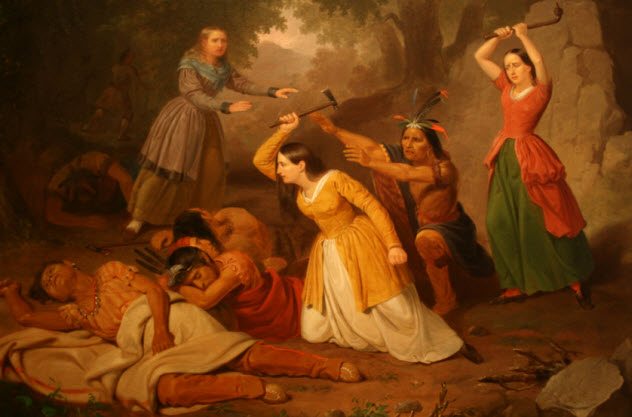 History
History  History
History  Weird Stuff
Weird Stuff 10 Everyday Products Surprisingly Made by Inmates
 Movies and TV
Movies and TV 10 Actors Dragged out of Retirement for One Key Role
 Creepy
Creepy 10 Lesser-Known Shapeshifter Legends from Around the World
 Animals
Animals 10 Amazing Animal Tales from the Ancient World
 Gaming
Gaming 10 Game Characters Everyone Hated Playing
 Books
Books 10 Famous Writers Who Were Hypocritical
 Humans
Humans 10 of the World’s Toughest Puzzles Solved in Record Time
 Mysteries
Mysteries 10 Scientific Mysteries We Don’t Fully Understand
 Weird Stuff
Weird Stuff 10 Celebrities Who Have Admitted to Alien Encounters
 History
History Ten Revealing Facts about Daily Domestic Life in the Old West
 Weird Stuff
Weird Stuff 10 Everyday Products Surprisingly Made by Inmates
 Movies and TV
Movies and TV 10 Actors Dragged out of Retirement for One Key Role
Who's Behind Listverse?

Jamie Frater
Head Editor
Jamie founded Listverse due to an insatiable desire to share fascinating, obscure, and bizarre facts. He has been a guest speaker on numerous national radio and television stations and is a five time published author.
More About Us Creepy
Creepy 10 Lesser-Known Shapeshifter Legends from Around the World
 Animals
Animals 10 Amazing Animal Tales from the Ancient World
 Gaming
Gaming 10 Game Characters Everyone Hated Playing
 Books
Books 10 Famous Writers Who Were Hypocritical
 Humans
Humans 10 of the World’s Toughest Puzzles Solved in Record Time
 Mysteries
Mysteries 10 Scientific Mysteries We Don’t Fully Understand
 Weird Stuff
Weird Stuff 10 Celebrities Who Have Admitted to Alien Encounters
Horrific Facts About Scalping On The American Frontier
Native Americans weren’t the only people who scalped their enemies. The European settlers who colonized the country learned from and copied them. Cutting off the skin on a man’s head became a widespread practice across the country—America’s dirty secret that plays a hidden role in every major moment in the nation’s history.
At first, the settlers of the New World treated scalping as a sign of barbarism and savagery. But as time went on and they struggled through more of life on the wild frontier, some started to see tearing the skin of a man’s skull as nothing worse than an efficient way to take home his head.
The American frontier became a brutal place where the scalps of dead men were a currency. White men and natives alike were massacring and mutilating innocent people for a fistful of cash—and the thin, delicate line between civilization and savagery slowly eroded away.
10 A Chief Tried To Impress Jacques Cartier With His Scalp Collection

Jacques Cartier may have been the first European to see a scalp firsthand. While in the area now known as Quebec City, he met with a tribal chief named Donnacona.
They greeted one another with courtesy. The tribe put on a dance of welcoming for the visiting explorers, and Cartier presented Donnacona with gifts. Then, to impress his new friend, Donnacona showed Cartier his most prized possession: five human scalps, dried out and stretched across hoops.[1]
Other Europeans would soon start writing home about it, describing warriors who would carve off the scalps of their dead enemies, raise them above, and let out a cry they called “the death cry.” The Native Americans, men reported, would bring the scalps of their enemies home on the tips of their lances. They would pass them around and make jokes about them, sometimes even feeding them to their dogs.
It was psychological warfare, meant to terrify, and it definitely worked on the Europeans. The record of Cartier’s voyage says little about their reaction. But after describing the scalps with hoops, the account ends with a stoic, “After seeing these things, we returned to our ships.”
9 Some People Were Scalped Alive

Scalping wasn’t just a way to claim a trophy from the body of a dead man. Some people were still alive and struggling when a warrior would pull back their head and slice off the skin at the top of their skulls.
We have medical records from doctors who had to treat the still-living victims of a scalping. Some were given a second chance at life. If a doctor acted fast, he could surgically repair the scalp and leave the person alive, with nothing worse than a disfiguring, bald scar that would cover the head for the rest of the person’s life.[2]
In the earlier days, though, the doctors weren’t as effective. The first treatments for scalped men had doctors pierce the skull to the bone marrow. Opening up little holes into the bone marrow, the doctors wrote, would make a “flesh projection” grow over the wound. But it would also leave them with a soft, thin spot on the top of their skulls and put them through excruciating pain.
Other people survived without treatment—but not for long. They would live for a few months with exposed bone at the top of their heads until infection set in. Their skulls would get inflamed, and the bone would start to separate, slowing exposing their bare, unprotected brains.
8 American Colonies Paid Bounties For Indian Scalps

Not long after the Mayflower set sail to the New World in search of a Christian utopia of peace and tolerance, white men started taking scalps.
The first scalps were claimed during the Pequot War. When a trader named John Oldham was killed by Native Americans, the Puritans of the Massachusetts Colony started fighting a full-on war with their neighbors. Soon, the governor was promising a reward for any man who could bring home the head of a Native American.
Heads, though, are large and cumbersome, and the men would have to come home with only a few kills under their belts to claim their reward. It wasn’t long before the Puritans picked up an idea from their enemies. They started cutting off scalps, filling bags with them, and bringing the scalps home instead.
Other colonies followed their lead. By 1641, the governor of New Netherlands put out the first official bounty on any and all scalps from a native’s head, promising “10 fathoms of wampum” for every scalp from a member of the Raritan tribe.[3]
The Massachusetts Bay Colony soon had their own, promising 40 pounds for the scalps of warriors and 20 pounds for women and children younger than 12 years old. Every citizen, the governor declared, was called upon to “embrace all opportunities of pursuing, capturing, killing, and destroying all and any of the aforesaid Indians.”
Hunting season had begun.
7 The Crow Creek Scalping Massacre

One of the worst scalping massacres of all time happened in 1325, more than 100 years before Columbus’s voyage, at a Native American town called Crow Creek.
The Crow Creek tribe had a massive town, with 55 lodges surrounded by a thick wall made of wood and buffalo hides. One night, while they were sleeping, an enemy tribe sneaked over their walls and massacred nearly every person there.
Archaeologists found the remains of 486 people at the site of the massacre. Nearly every person in the town was scalped after they were killed—except for the young women, who were taken back as sex slaves for the men who’d killed their husbands.[4]
Since the only thing we know about the massacre is what we can find in the remains of the victims, nobody knows for sure who did it. By the time Europeans made it to the site of Crow Creek, though, the Arikara tribe was telling stories about a great big village that had to be taught a lesson—which might just be a clue.
6 Hannah Duston Scalped Her Captors

Hannah Duston was a housewife, the mother of eight children, and the last person you’d expect to walk into a governor’s office demanding the bounty for her 10 scalps.
Her story begins in 1697 when her home in Haverhill, Massachusetts, was attacked by the Abenaki tribe. Her husband, Thomas, fled with seven of their children, but he left Hannah and their newborn daughter behind. Hannah watched in horror as 27 people in her village were murdered. Then her Abenaki captor pulled her newborn baby girl from her arms and smashed the baby’s head against a tree.
The Abenaki dragged Hannah to an island to be their captive, but Hannah spent every second looking for her chance for revenge. She waited until they fell asleep. Then she grabbed a tomahawk and rammed it into the heads of the 10 Abenaki people holding her hostage.
She cut off their scalps before she escaped.[5] Then she brought the other hostages to a canoe and rescued them all.
And that’s how a middle-aged mother, thought to be dead, showed up at the Massachusett governor’s office with the biggest collection of scalps they’d ever seen and demanded her reward.
5 US Rangers Went On Scalp-Hunting Expeditions

In the early 1700s, some US Rangers started working as full-time scalp collectors. They would go into the wilderness looking for Native Americans to kill, determined to bring home a bag full of scalps and make a small fortune.
One of the most successful was John Lovewell, who became a minor celebrity for the number of scalps he brought home. At one point, he made a wig from the torn scalps of the men he’d killed. Then Lovewell paraded through the streets of Boston wearing the wig on his head.
Scalping was profitable. Lovewell wasn’t just famous—he was rich. He got 100 pounds for every scalp he brought home, which was a lot of money at the time. Killing Native Americans had made him more money than he’d ever earned in his life.
It also ended up getting him killed. He organized a group of 47 men to take a village of more than 100 people. Likely, he hoped to split the profits among as few people as possible. He’d overestimated his own abilities, though. Lovewell was killed in the battle—and, appropriately enough, scalped.[6]
4 Henry Hamilton Paid Indians For The Scalps Of American Revolutionaries

During the American Revolution, a British man called Henry Hamilton earned the nickname “The Hair-Buyer General.”[7] He was in charge of getting Native American tribes to help Britain beat down the American Revolutionaries—and he did it by buying scalps.
Hamilton didn’t exactly have progressive opinions. He wrote about the Native Americans as “savages,” arguing that Britain should take advantage of their “natural propensity . . . for blood.” He paid the Native Americans for every white man’s scalp they could bring home, only telling them not to “redden your axe with the blood of women and children.”
Hamilton provided the natives with scalping knives and kept records of how many scalps they brought in. In his biggest haul, he was given 129 American scalps in a single day.
But scalping only brought about more scalping. As the Americans watched their men die, they struck back—and started scalping Hamilton’s mercenaries as brutal acts of revenge.
3 A Kentucky Militia Would Strip Naked And Take Scalps

The next time that the United States and Britain went to war, some Americans had fully embraced the idea of scalping their enemies. By the time the War of 1812 had begun, a militia group from Kentucky had gone completely savage.
The Kentucky Militia would strip down to their underwear and daub themselves with red war paint before attacking British and Native American camps. The militia murdered every person they could find and tore off their scalps. There wasn’t a cash reward for doing it—they just wanted a memento of their massacres.
One officer from Pennsylvania wrote in his journal that he’d been sitting next to a soldier from Kentucky when, without warning, the Kentuckian “ripped open his waistband, fleshed them with his knife, salted them, and set them in hoops.”[8]
Most of the country was disgusted by this. The British used it in propaganda, calling Kentuckians “the most barbarous, illiterate beings in America.”
But the Kentuckians didn’t care. One young soldier wrote that he’d sent a scalp home to his parents the first chance he got. “Daddy and Mamma,” the soldier wrote, “thought I had done about right.”
2 The Sand Creek Massacre

When the Civil War began, some soldiers got sidetracked over a dispute with the local Cheyenne tribe. They had been accused of stealing livestock, and the Union troops wouldn’t stand for it. In retaliation, a group led by Colonel John Chivington started burning down Cheyenne camps.
The Cheyenne didn’t want any trouble. Their chief, Black Kettle, came to Chivington begging for peace, saying, “We want to take good tidings home to our people, that they may sleep in peace.” Chivington told Black Kettle that he wasn’t authorized to make peace—and then made plans to massacre the village of Sand Creek.
“Damn any man who sympathizes with Indians,” Chivington declared. “Kill and scalp all, big and little; nits make lice.”
A white man named John Smith had a son in the camp who died with the others. He went in to claim his dead and saw the horrifying scene firsthand. “I saw the bodies of those lying there cut all to pieces,” he reported. They had been scalped and brutalized, with their children killed and unborn babies ripped out of wombs.[9]
The worst, though, was the body of a man called White Antelope. After he was scalped, his nose and ears were cut off and his testicles were removed and turned into a tobacco pouch—a keepsake for army men who had slaughtered a peaceful village.
1 The Glanton Gang Scalped Mexicans For Cash

During the Mexican-American War, Texas Ranger John Joel Glanton took up a job collecting scalps from the Apache tribe. Some of the Apache had become involved in the fighting, and the American Army wanted them out of the way. So they paid handsomely for every scalp that Glanton could bring in.
This made Glanton rich. But fairly soon, he started running out of Apaches to kill. The US Army, though, wasn’t really checking where his scalps came from. So he started killing Mexican civilians instead and passing them off as Apaches.[10]
After a while, Glanton’s bloodlust turned him into a full-on serial killer. He and his gang stole a river ferry from some members of the Yuma tribe and invited people to ride in his boat. Once the people were trapped in the middle of the water, Glanton and his men would massacre them—whether they were Mexicans or Americans—and loot their dead bodies.
The Chihuahua government put a bounty on his head, but it was the Yuma who got him. They were normally a peaceful tribe, but Glanton had pushed them too far. While he was sleeping, the Yuma tribe sneaked into his camp. They killed his cohorts and slit Glanton’s throat while he was sleeping.
Read about more atrocities committed on the American frontier on 10 Horrific Native American Massacres and 10 Horrifying Stories Of Life In The Wild West.








